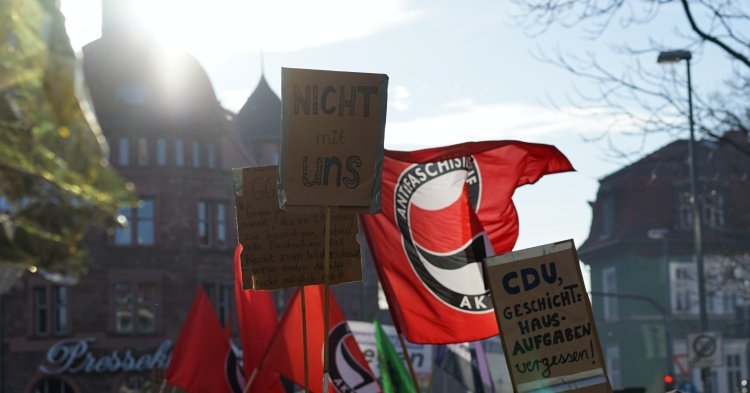
Moritz Hergl on Germany: No end in sight?
Since the end of World War II, the Nazi past has served as a breeding ground for extreme right-wing acts of violence. In post-war Germany, numerous paramilitary groups formed under the guise of anti-communism. In the 1970s and 1980s, far-right terrorist groups killed more than two dozen people and carried out attacks on Jewish citizens and foreigners. While many of the attacks were carried out by lone warriors, the authorities also investigated several terrorist groups. Often involved were members of the “Nationaldemokratische Partei Deutschlands” (NPD). In the early 1970s, the right-wing extremist party was represented in seven state parliaments and represented a nationalist ideology. According to a ruling of the Federal Constitutional Court in 2017 the party is “anti-constitutional, but currently no threat to the liberal-democratic basic order”.
The series of attacks by the National Socialist Underground (NSU) began in 2000. The florist Enver Şimşek is believed to be the first victim of the terrorists Uwe Böhnhardt, Uwe Mundlos, and Beate Zschäpe. For over ten years, they had been in hiding and built a nationwide right-wing network of supporters. They murdered nine migrants and a policewoman, carried out a nail bomb attack in a Cologne shopping street and raided banks. Their motive: racism. Yet, the police investigations had largely ruled out such a far-right connection. The connection between the crimes only became clear after the suicide of Böhnhardt and Mundlos and the arrest of Zschäpe in 2011 - even though more than 40 members of the Verfassungsschutz (from the Office for the Protection of the Constitution) had been close to the NSU.
In Germany, acts of right-wing terrorism are still not a thing of the past. In 2015, Henriette Reker, the CDU candidate for the mayoral election in Cologne, narrowly escaped an attack. In June 2019, Walter Lübcke, a CDU politician and local government president, was shot and killed. Both had been campaigning for a liberal asylum policy. The synagogue in Halle was a target of right-wing extremist violence in October 2019. When the perpetrator failed to break into the church, he shot a woman on the streets and a man in a kebab shop. On February 19, 2020, hatred and terror from the right reached another sad climax: in Hanau, a right-wing extremist shot nine migrants in two hookah bars.
Right-wing extremism was, and still is, a structural problem in Germany - and will probably remain so. Despite numerous promises, the government and authorities seem unable to successfully contain right-wing violence.

Silvia Fallone on Italy: the Dangers of “Dog-Whistle” Fascism
Known today as “terrorismo nero” (“black terrorism”), armed right-wing subversions have led to deep political and social unrest in Italy since the end of the Second World War.
Since the demise of fascism, the economic boom of the 1950s and throughout the Anni di Piombo (“Years of Lead”), the process of extreme polarization of political rhetoric has brought about many notable terrorist attacks and acts of violence - such as the Strage di Piazza Fontana (Piazza Fontana bombing), or the Strage di Bologna (Bologna massacre) - with a total of over 478 victims from 1969 and 1983.
Throughout the following years, many conspiracy theories developed - some of which still exist today, including the involvement of the Italian intelligence agencies in most of the attacks. They are believed to have conspired to murder Aldo Moro, a promiment member of the of the majority party, Democrazia Cristiana (Cristian Democracy), in order to prevent their alliance with the Italian Communist Party (PCI). At times, the line between right and left-wing terrorism has become difficult to spot.
Fast forward to 30 years later, in December 2013 Matteo Salvini was elected Secretary of the Italian far-right party Lega Nord (The North League). His Twitter-based, rhetorically populist propaganda has been accused of political “dog-whistling” towards right-wing extremists. “Dog-whistling” in political statements is the use of language which may not stand out to the general public but send a coded message to particular groups. In Salvini’s case, such language was aimed at members of the newly-founded neo-fascist movements Forza Nuova and CasaPound Italia. Together with Salvini’s, another party whose members represent a decent portion of the right-wing Italian MPs, Fratelli d’Italia (Brothers of Italy), has often shown support towards the fascist cause - even bracing the candidacy of Mussolini’s great grandson, Caio Giulio Cesare Mussolini, to the 2019 European Parliament elections.
The direct result of such a political climate is the increasing number of acts of violence attributable to members of the Italian neo-fascist movements. From 2014 to 2018, Italy has experienced a 400% increase in the number of politically motivated offences, including the arrest of several members of Forza Nuova, who were found in possession of rifles, machine guns and even a French war missile.
Unfortunately, even today, such forms of extremism are still underestimated, downplayed or even unacknowledged by Italian government officials.

Théo Boucart on France: Islamism and Ultra-Rightism - two sides of the same plague
When we look at the official figures, we see that terror attacks perpetrated by Islamist groups have caused many more casualties than terror attacks organized by far-right activists. Considering the massive attacks that the country endured in the middle of the last decade (and especially the attacks in Paris on November 13th 2015 that killed 130 people and injured 413 others), this is not a surprise. Since then, the attention of much of the media and some politicians is focused on what is supposed to be happening in suburbs considered ‘hotbeds’ of Islamism, such as in the outskirts of Paris, Marseille, Montpellier or Toulouse.
However, we must not forget how dangerous far-right or even ultra-right groups may be. In the last few years, a dozen people were arrested by the police for planning attacks. Last October, a man tried to set fire to the Mosque of Bayonne, in the South-West of France, injuring two men. According to the French political scientist Jean-Yves Camus, the number of ultra-right groups planning attacks against Muslims has neither increased nor decreased since the Islamist attacks in 2015/16. However, some of their members are called the “children of November 13th 2015” because they want to harm the Muslim community in France in retaliation for the major terror attacks which have occurred on French soil since 1945.
Furthermore, France is a hotbed of conspiracy theories, which are becoming increasingly popular on the “dark web”. One of these wild theories is the so-called “Great Replacement” (Grand Remplacement), which was set out in the far-right activist Renaud Camus’ eponymous book. The theory asserts that the white and Christian European culture is being replaced by waves of Muslim non-European immigrants in order to achieve the “destruction of French civilization” (sic). Yet, victims of both Islamist and far-right terrorism are the same: French citizens who want to live peacefully, regardless of their cultural background.

Xesc Mainzer about Spain: distant memories or a possible scenario?
Far-right terrorism seems to be a distant memory to most Spaniards. It was in the late 1970’s and early 1980’s when armed far right groups would act with impunity taking advantage of the precariousness of the nascent post-Francoist democracy. Most of these groups had the intention of stopping the political transition towards democracy and fully restoring the dictatorial regime. Between 1975 and 1983, it is estimated that up to 60 people were killed by Spanish far-right terrorist groups.
Though various groups and individuals linked to the left were targeted, the Basque terrorist group ETA was a recurrent target. Until the late 1980s, state-sponsored terrorism continued the task of fighting the ETA. Though the existence of both far-right and state-sponsored terrorism is widely accepted, it is often overlooked to maintain the fictional image of a peaceful democratisation process, going as far as ignoring hundreds of victims of political violence (both due to terrorism and police repression).
Since the mid-1980’s, almost no episodes of armed far-right violence have taken place. Such pacification is the result of a larger process of democratic consolidation, in which the amalgamation of the political groupings of the centre-right into a single catch-all party, which neglected extreme right-wing ideas, played an essential role.
After almost four decades without right wing terrorism, anyone could say the threat is already over. However, the split of the right-wing political spectrum into different parties, including an openly far-right platform like Vox, which brings extremist ideas into the mainstream and thus normalises them, leaves many uncertainties ahead. In a world where far-right terrorism is resurgent, where populism is growing endlessly and where political instability is becoming the norm, ruling out far-right terrorist activity would be nothing more than wishful thinking for any society, even Spain’s.

Ioana Petrescu about Romania: From Racism to Right-wing Terrorism?
The 2019 terror attacks in Halle followed by the one in Hanau 2020 have sent shockwaves through Europe. They have reminded citizens of the atrocities resulting from a deeply racist and chauvinistic mentality, and of how likely such events are to happen, since the methods of prevention are either not sufficiently effective or perhaps lacking completely. In Romania, racism, xenophobia, anti-semitism, sexism and other forms of discrimination are present. Right-wing populist discourses are still widespread, both in politics and in popular culture, most notably in the now defunct newspaper Romania Mare (The Great Romania) and in hip-hop songs.
In contrast, however, these principles have not become institutionalized in Romania and explicitly right-wing terrorist attacks have not taken place in the last twenty years. In terms of parliamentary representation, no extreme right-wing parties have managed to obtain the necessary votes to secure any seats in parliament. An example is the New Generation Party which has not participated in elections since 2014 due to insufficient electoral support. Subsequently, it has been the target of international criticism, being declared “an extremely nationalist party” by the US. Furthermore, state efforts have been made to combat the spread of racism through the passing of legislation concerning national safety, in which the Intelligence Service gathers information about extreme right-wing groups and provides it to law enforcement departments, agencies or governmental institutions.
Moreover, ethnic minority organizations are offered parliamentary representation. As of 2018, there are 18 seats devoted to such groups in the Chamber of Deputies. On the other hand, however, there have been several racially motivated attacks towards the Romani community, which have not been thoroughly addressed at a societal level.




Follow the comments: |
|
